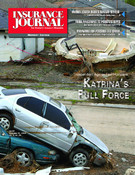A New Federal Law Encourages Airports to Build Safety Zones or Extend Runways by 2015
A deadly accident in which a Boeing 737 slid off the end of a snowy Chicago runway on Dec. 8 brought renewed demands for buffer zones or other safety measures at hundreds of airports around the nation to give pilots a wider margin for error.
In that recent tragedy at Midway Airport, a Southwest Airlines jet making a landing plowed through a fence and into a street, killing a 6-year-old boy from in a car. At least 10 other people, most on the ground, were injured.
The National Transportation Safety Board said the cause of the accident was under investigation. The plane’s voice and data recorders were sent to Washington for analysis and are said to hold “pristine” information investigators can use, according to NTSB member Ellen Engleman Conners. But much of the attention focused on the 6,500-foot runway.
Buffer zones
Like nearly 300 other U.S. commercial airports, Midway lacks 1,000-foot buffer zones at the ends of its runways. Midway, a compact one mile square, was built in 1923 during the propeller era and has shorter runways than most major airports, with no room to extend them because it is hemmed in by houses and businesses.
Safety experts say such airports can guard against accidents by instead using beds of crushable concrete that can slow an aircraft if it slides off the end of a runway.
The concrete beds, called Engineered Material Arresting Systems, or EMAS, are in place at the end of 18 runways at 14 airports. They have stopped three dangerous overruns three times since May 1999 at Kennedy Airport in New York.
“Certainly Midway airport officials should have already been trying to come up with something similar to this,” said Jim Hall, NTSB chairman from 1993 to 2001. “There’s really no margin for error at the end of that runway.”
Hall said the lack of a 1,000-foot overrun area and the absence of an EMAS system would probably be a key focus of the investigation.
“The bottom line is you have an increasing frequency of flights on a runway with an inadequate margin for error,” he said. “It’s a tragedy that did not have to occur.”
Chicago Department of Aviation spokeswoman Wendy Abrams could not immediately say whether an arresting system had been considered at Midway.
Though the airport had about 7 inches of snow, aviation officials said conditions at the time were acceptable. The plane did not appear to have any maintenance problems and had undergone a service check the day before in Phoenix, Southwest chief executive Gary Kelly said.
Southwest said the 59-year-old captain has been with the airline for more than 10 years, and the 35-year-old first officer has flown with Southwest for more than two years.
It was the first fatal crash in Southwest’s 35-year history.
A recently passed federal law seeks to encourage more airports to build EMAS systems or extend their runway barriers by requiring them to do one or the other by 2015. There are 284 such airports with neither feature, according to the FAA.
Federal measure
Sen. Frank Lautenberg, D-N.J., sponsored the measure after several runway overruns at his home state’s Teterboro Airport, near New York. Last February, a corporate plane carrying 11 people ran off the end of the Teterboro runway during an aborted takeoff, sped across a busy road and hit a warehouse. Twenty people were injured.
“My bill, which was signed into law last week by the president, will finally force these airports and the FAA to make these runways safer,” he said.
In June 1999, an American Airlines jetliner slid past the end of the runway in Little Rock, Ark., killing 11 passengers and injuring 86. It was only the remarkable speed of the passengers’ evacuation — less than two minutes — that prevented serious injury or death when an Air France Airbus skidded off the runway in Toronto and burst into flames in August.
Hall was NTSB chairman when a Southwest Airlines 737 overran a runway at Burbank Airport near Los Angeles, stopping within feet of a gas station. Burbank’s runway is even shorter than Midway’s at 5,800 feet.
Scapegoat
But other safety experts said the length of the runway should not be used as a scapegoat in overrun accidents.
“It is not the runway length that’s the issue,” said Bernard Loeb, who was director of aviation safety at the NTSB during the mid-1990s. “Runways are either adequate or they’re not.”
Some pilots acknowledged that relatively short runways like Midway’s pose a challenge in icy or snowy weather, forcing them to touch down as close as possible to the beginning of the runway to allow more braking time.
“The shorter the runway, the quicker you want to get it on the ground, especially landing on ice and snow,” said Bert Yetman, a retired Southwest captain. “If you’re not down in the first 1,000 feet or so, take it around and try it again.”
Paul Czysz, professor emeritus of aerospace engineering at Saint Louis University, likened landing at Midway in bad weather to landing on an aircraft carrier.
“You’ve got to stick it and brake like heck,” Czysz said. “But poor visibility and any wind shear can make that tough to do.”
Topics Aviation
Was this article valuable?
Here are more articles you may enjoy.


 Viewpoint: Deepfake Fraud Is On the Rise. Here’s How Insurers Can Respond
Viewpoint: Deepfake Fraud Is On the Rise. Here’s How Insurers Can Respond  Surplus Lines Commercial Growth; Fla. Litigation Costs Reach New High in 2023
Surplus Lines Commercial Growth; Fla. Litigation Costs Reach New High in 2023  Study Urges Rethinking of Disaster Management in Era of Compounding Events
Study Urges Rethinking of Disaster Management in Era of Compounding Events  Hurricane Beryl: Insurers See Minimal Impact, Brace for Active Season
Hurricane Beryl: Insurers See Minimal Impact, Brace for Active Season 


